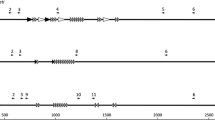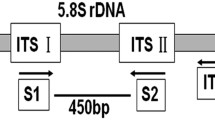Abstract
Ability to detect Pseudocercospora macadamiae infection in macadamia husk at least four months before symptoms become visible will aid the development of disease control measures. This study examined the distinctness of P. macadamiae within the phylogenetic lineages of the genus Pseudocercospora. In addition, we developed two quantitative PCR (qPCR) assays, as rapid diagnostic tools, for early detection and quantification of P. macadamiae in planta. Phylogenetic analysis of concatenated sequences of four gene loci (large subunits, internal transcribed spacer (ITS), translation elongation factor 1-alpha (TEF-1α) and actin of 47 P. macadamiae isolates showed that P. macadamiae is a distinct species in the genus Pseudocercospora. P. macadamiae isolates were partitioned into subunits in the cluster but the grouping of the isolates was regardless of location. Nucleotide diversity (0.02) and the coefficient of genetic differentiation (0.07) were low in the P. macadamiae population. Two qPCR primer sets, based on ITS (PMI) and TEF-1α (PME) were designed that consistently amplified P. macadamiae in fungal cultures (Ct = 16.93 ± 0.11 and Ct = 21.20 ± 0.11, respectively) and in planta (Ct = 32.36 ± 0.28 and Ct = 38.07 ± 1.20, respectively). The PMI primers also detected species in the genus Pseudocercospora, while PME was more specific and robust for quantification of P. macadamiae. Both primer sets detected P. macadamiae in asymptomatic tissue samples and strongly differentiated various stages of disease progression, which revealed approximately 10-fold increase in fungal biomass between each consecutive stage of symptom development.





Similar content being viewed by others
References
Akinsanmi, O. A., Miles, A. K., & Drenth, A. (2007). Timing of fungicide application for control of husk spot caused by Pseudocercospora macadamiae in macadamia. Plant Disease, 91, 1675–1681.
Akinsanmi, O. A., Miles, A. K., & Drenth, A. (2008). Alternative fungicides for controlling husk spot caused by Pseudocercospora macadamiae in macadamia. Australasian Plant Pathology, 37, 141–147.
Akinsanmi, O. A., Topp, B., & Drenth, A. (2012). Pericarps retained in the tree canopy and stomatal abundance are components of resistance to husk spot caused by Pseudocercospora macadamiae in macadamia. Euphytica, 185, 313–323.
Altschul, S. F., Gish, W., Miller, W., Myers, E. W., & Lipman, D. J. (1990). Basic local alignment search tool. Journal of Molecular Biology, 215, 403–410.
Beilharz, V., Mayers, P. E., & Pascoe, I. G. (2003). Pseudocercospora macadamiae sp. nov., the cause of husk spot of macadamia. Australas. Plant Pathology, 32, 279–282.
Brisson, M., Hall, S., Hamby, R. K., Park, R., & Srere, H. K. (Eds.) (2004). Optimisation of single and multiplex real-time PCR. USA: International University Line.
Capote, N., Pastrana, A.M., Aguado, A., Sánchez-Torres, P., 2012. Molecular Tools for Detection of Plant Pathogenic Fungi and Fungicide Resistance. In: Cumagun, C.J. (Ed.), Plant Pathology. InTech, pp. 151–202.
Carbone, I., & Kohn, L. M. (1999). A method for designing primer sets for speciation studies in filamentous ascomycetes. Mycologia, 91, 553–556.
Crous, P. W., Braun, U., Hunter, G. C., Wingfield, M. J., Verkley, G. J. M., Shin, H.-D., et al. (2012). Phylogenetic lineages in Pseudocercospora. Studies in Mycology, 75(1), 37–114.
Deighton, F. C. (1976). Studies on Cercospora and allied genera. VI. Pseudocercospora Speg., Pantospora Cif. And Cercoseptoria Petr. Mycological Papers, 140, 1–168.
Drenth, A., Akinsanmi, O. A., & Miles, A. K. (2009). Macadamia diseases in Australia. Southern African Macadamia Growers’ Association Yearbook, 17, 48–52.
Francis, W. D. (1928). The anatomy of the Australia bush nut (Macadamia ternifolia). Proc. R. Soc. Queensl., 39, 43–53.
Hartl, D. L., & Clark, A. G. (1997). Principles of population genetics. Sunderland, MA: Sinauer Associates, Inc..
Hasegawa, E., Ota, Y., Hattori, T., & Kikuchi, T. (2010). Sequence-based identification of Japanese Armillaria species using the elongation factor-1 alpha gene. Mycologia, 102, 898–910.
Kristensen, R., Torp, M., Kosiak, B., & Holst-Jensen, A. (2005). Phylogeny and toxigenic potential is correlated in Fusarium species as revealed by partial translation elongation factor-1 alpha gene sequences. Mycological Research, 109, 173–186.
Leina, M. J., Tan, T. K., & Wong, S. M. (1996). Resistance of Hibiscus esculentus L. And Vigna sinensis (L.) Endl. To Pseudocercospora and plant peroxidase activity in relation to infection. The Annals of Applied Biology, 129, 197–206.
Librado, P., & Rozas, J. (2009). DnaSP v5: a software for comprehensive analysis of DNA polymorphism data. Bioinformatics, 25, 1451–1452.
Mayers, P. E., & Hutton, D. G. (1987). Husk spot of macadamia in Queensland and its control. In T. Trochoulias & I. Skinner (Eds.), Proceedings of the second Australian macadamia research workshop (pp. 146–151). Bangalow: Australian Macadamia Society.
McDermott, J. M., & McDonald, B. A. (1993). Gene flow in plant pathosystems. Annual Review of Phytopathology, 31, 353–373.
Miles, A. K. (2011). Husk spot disease of macadamia. Phd Thesis. Brisbane: University of Queenland.
Miles, A. K., Akinsanmi, O. A., Sutherland, P. W., Aitken, E. A. B., & Drenth, A. (2009). Infection, colonisation and sporulation by Pseudocercospora macadamiae on macadamia fruit. Australasian Plant Pathology, 38, 36–43.
Miles, A. K., Akinsanmi, O. A., Aitken, E. A. B., & Drenth, A. (2010a). Timing of infection of macadamia fruit by Pseudocercospora macadamiae and climatic effects on growth and spore germination. Australasian Plant Pathology, 39, 453–462.
Miles, A. K., Akinsanmi, O. A., Aitken, E. A. B., & Drenth, A. (2010b). Source of Pseudocercospora macadamiae inoculum in macadamia trees and its use for characterising husk spot susceptibility in the field. Crop Protection, 29, 1347–1353.
Nei, M. (1973). Analysis of gene diversity in subdivided populations. Proceedings of the National Academy of Sciences of the United States of America, 70, 3321–3323.
Newett, S.D.E., 1983. Observations on cercospora husk spot in macadamia. Proceedings of the first australian macadamia research workshop.
Ross-Davis, A. L., Hanna, J. W., Kim, M. S., & Klopfenstein, N. B. (2012). Advances toward DNA-based identification and phylogeny of north American Armillaria species using elongation factor-1 alpha gene. Mycoscience, 53, 161–165.
Seifert, K., & Levesque, C. A. (2004). Phylogeny and molecular diagnosis of mycotoxigenic fungi. European Journal of Plant Pathology, 110, 449–471.
Storey, W. B. (1965). The ternifolia group of Macadamia species. Pacific Science, 15, 507–514.
Strohschen, B. (1986). Contributions to the biology of useful plants. IV. Anatomical studies of fruit development and fruit classification of the macadamia nut (Macadamia integrifolia maiden and Betche). Angewandte Botanik, 60, 239–247.
Tajima, F. (1989). Statistical method for testing the neutral mutation hypothesis by DNA polymorphism. Genetics, 123, 585–595.
Tamura, K., Stecher, G., Peterson, D., Filipski, A., & Kumar, S. (2013). MEGA 6: molecular evolutionary genetics analysis version 6.0. Molecular Biology and Evolution, 30, 2725–2729.
Vilgalys, R., & Hester, M. (1990). Rapid genetic identification and mapping of enzymatically amplified ribosomal DNA from several Cryptococcus species. Journal of Bacteriology, 172, 4238–4246.
White, T. J., Bruns, T., Lee, S., & Taylor, J. (1990). Amplification and direct sequencing of fungal ribosomal RNA genes for phylogenetics. In M. A. Innis, D. H. Gelfand, J. J. Sninsky, & T. J. White (Eds.), PCR protocols (pp. 315–322). San Diego: A guide to methods and applications. Academic Press.
Wright (1993). Investigations contributing to the knowledge of pathogenicity and genetic variability of the macadamia husk spot pathogen, Pseudocercospora sp. BSc Honours. Brisbane: University of Queensland.
Zahn, M., Teuber, F., Bollig, K., & Horst, W. J. (2011). Quantification of Pseudocercospora fuligena in tomato lines carrying introgressions from Solanum habrochaites using a qPCR assay. Plant Disease, 95, 394–400.
Acknowledgments
Ong CE acknowledges the scholarship received from the Public Service Department of Malaysia for her Bachelor of Agriculture with Honours degree program at The University of Queensland. The authors are grateful to Ms. Cecilia O′ Dwyer for her technical assistance and the Queensland Plant Pathology Herbarium (BRIP) culture collection for providing the cultures used in this study.
Author information
Authors and Affiliations
Corresponding author
Rights and permissions
About this article
Cite this article
Ong, C.E., Henderson, J. & Akinsanmi, O.A. Characterization and development of qPCR for early detection and quantification of Pseudocercospora macadamiae at different stages of infection process. Eur J Plant Pathol 147, 85–102 (2017). https://doi.org/10.1007/s10658-016-0982-y
Accepted:
Published:
Issue Date:
DOI: https://doi.org/10.1007/s10658-016-0982-y




